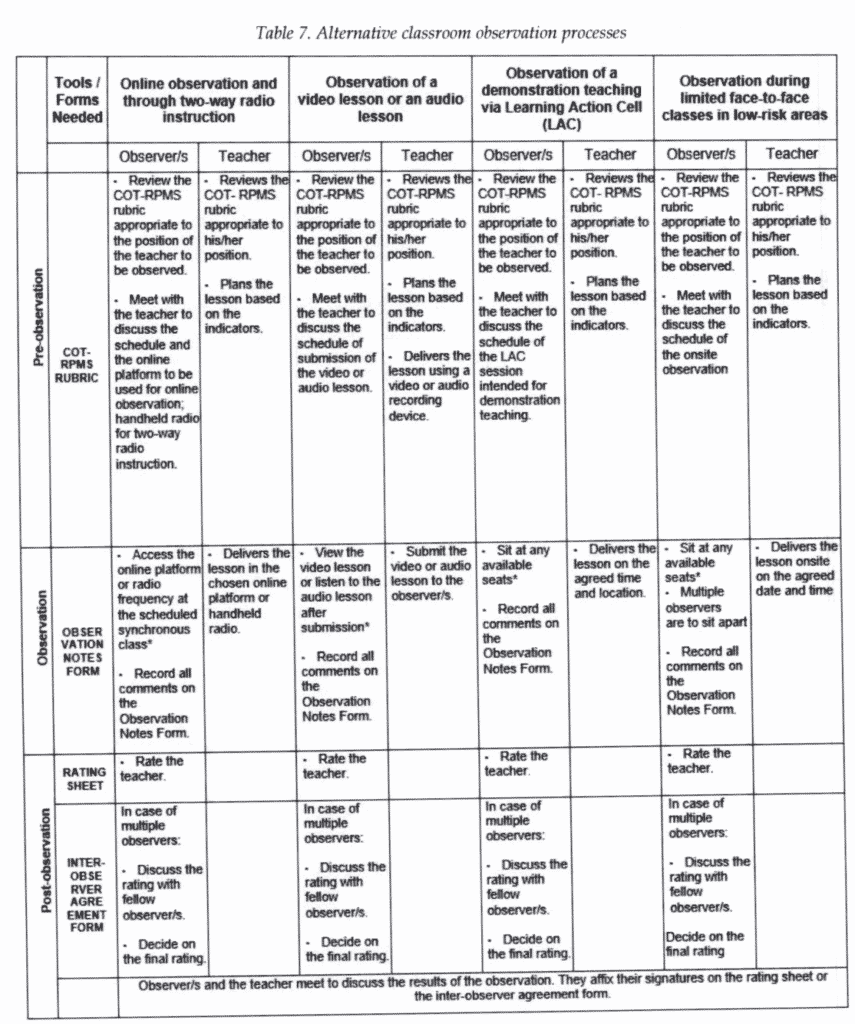The alternative classroom observations for RPMS are considered only for SY 2021-2022 due to the absence of or limited capacity for face-to-face learning. The selection of alternative classroom observation shall depend on the adopted Learning Delivery Modality (LDM) of the school.
Table of Contents
Alternative Classroom Observations and Their Corresponding Guidelines
| Alternative Classroom Observations | Guidelines |
| 1. Observation of real-time teaching (online synchronous learning or two-way radio instruction) | This applies to teachers who will adopt online synchronous learning or two-way radio instruction regardless of the number of classes and learners. |
| 2. Observation of a video lesson or an audio lesson | • Consider this mode of observation when option 1 is not possible. • This applies to teachers who will adopt online asynchronous learning or audio lesson in any of their classes and learners. • A video lesson or audio lesson shall be used in lesson delivery as part of the supplementary materials or as one of the learning materials for online asynchronous learning or two-way radio instruction. It is not the same as the video lesson for TV-based instruction or audio lesson for radio-based instruction that the Central Office/Regional Office/Division Office produces. • A video lesson or audio lesson must be SLM-based or MELC-aligned. A teacher can use any recording device to record herself/him self while teaching a lesson. • A video lesson or audio lesson can be stored in a cloud (e.g., Google Drive) or any storage device (e.g., flash drive), or uploaded to an online classroom (e.g., Google Classroom) or a Learning Management System. |
| 3. Observation of a demonstration teaching via Learning Action Cell (LAC) | • Consider this mode of observation when options 1 and 2 are not possible. • This applies to teachers who will adopt pure modular learning (print/digital), radio-based instruction (e.g., DepEd Radio), and TVbased instruction (e.g., DepEd TV). • In DepEd’s BE-LCP in the time of COVID-19, “a support mechanism shall be established for teachers and school leaders to have access to relevant on-demand technical and administrative advice and guidance which come in many forms. . .including professional learning communities through the LAC” (DepEd Order No. 12, s. 2020, p. 41). In support of this mechanism, the LAC policy states that school LAC “primarily functions as a professional learning community for teachers that will help them improve practice and learner achievement” (DepEd Order No. 35, s. 2016, p. i). |
| 4. Observation during limited face-to-face classes in low-risk areas | This shall only apply to authorized public and private schools that are located in minimal- or low-risk areas based on the criteria set by the Department of Health (DOG), and passed the school safety assessment of DepEd. • Authorized public and private schools that are allowed to conduct limited face-to-face classes shall follow the usual classroom observation protocols subject to strict observance of COVID-19 health and safety precautions and prevailing community quarantine |
There should be two (2) classroom observations for the entire school year. Hence, ratees should submit 2 classroom observation tool (COT) rating sheets/inter-observer agreement forms as MOV for objectives that require such (i.e., Objectives 1, 3, 4, 5, 6, 9 and 10). The alternative classroom observations should follow this timeframe:
• CO 1 – between September 2021 and February 2022
• CO 2 – between March 2022 and July 2022
See Appendix 6 for the FAQs (frequently asked questions) on the alternative classroom observations.
Classroom Observation Processes in the New Normal
Given the implementation of different teaching-learning modalities, various classroom observation processes can be done depending on the applicable context and modalities adopted by the school. The pre-observation, observation, and post- observation are still to be followed with minimal modifications as shown in the table below.
Table 7. Alternative Classroom Observation Process
- For highly proficient teachers, a proof of attendance during observation is part of their MOV. Hence, the following protocols should be observed:
1) Online synchronous learning or two-way radio instruction – (i) Invite your colleague/s to sit in your synchronous class, (ii) Have an attendance sheet signed after the class.
2) Observation of a video or audio lesson – (i) Give a copy of your video or audio lesson to your colleague/s which they should view, (ii) Have an attendance sheet signed afterwards. (Note: Observer/s must ensure that colleague/s view the video lesson or listen to the audio lesson.)
3) Observation of a demonstration teaching via LAC – (i) Invite your colleague/s to observe your demonstration teaching during a LAC session, (ii) Have an attendance sheet signed afterwards.
4) Observation during limited face-to-face classes in low-risk areas – (i) Invite your colleague/s to sit in your limited face-to-face, (ii) Have an attendance sheet signed after the class.
READ:
- Implementation of the RPMS-PPST for School Year 2021-2022
- Download DepEd RPMS Tools for SY 2021-2022
- RPMS-PPST Performance Objectives, Indicators, and Means of Verifications for SY 2021-2022
- RPMS Teacher Reflection Form (TRF) Rubric for Master Teacher I-IV
- RPMS Teacher Reflection Form (TRF) for Teacher I-III
- RPMS Teacher Reflection Form (TRF) Rubric for Teacher I-III
- RPMS Teacher Reflection Form (TRF) for Master Teacher I-IV
- Self-Assessment Tool for Teacher I-III (Proficient Teachers) for SY 2021-2022
- Self-Assessment Tool for Master Teacher I-IV (Highly Proficient Teachers) for SY 2021-2022
- Classroom Observation Tools-RPMS Inter-Observer Agreement Form
- Classroom Observation Tools-RPMS Observation Notes Form
- Classroom Observation Tool (COT)-RPMS Teacher I-III Rating Sheet
- Classroom Observation Tool (COT)-RPMS Master Teacher I-IV Rating Sheet
- Classroom Observation Tools-RPMS for Highly Proficient Teachers (Master Teacher I-IV)
- Classroom Observation Tools-RPMS for Proficient Teachers (Teacher I-III)

Thank you for sharing these resources.
Good day
Gusto ko lang sana hingi tulog our children school at private suddenly we cannot afford the tuation we transfr our children in public school .. we are willing to pay the tuation bill but only half so we can gate the list of the child